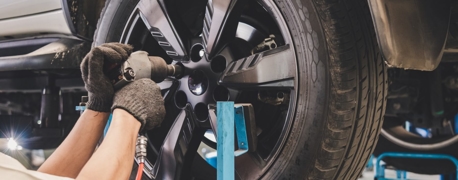The Most Dangerous Highway in West Texas: US 285

US Route 285, known by locals and frequent travelers as the “Death Highway,” is one of the most dangerous stretches of road in West Texas and nationwide.
But it isn’t bad luck that makes this highway one of the deadliest in the United States (in 2013, US 285 had a fatality rate higher than any other freeway in the country). The presence of tractor-trailers, out-of-town drivers, and poorly maintained roads have all been blamed for US 285’s high accident rate.
What do all of these have in common? They’re linked to the oil and gas industry.
Highway 285 runs through the Permian Basin, an immense sedimentary basin spanning about 86,000 square miles in western Texas and southeastern New Mexico. The Permian Basin “represents the most prolific hydrocarbon production region in the United States,” according to the U.S. Energy Information Administration. In 2020, the Permian Basin accounted for approximately 30% of crude oil production and 14% of natural gas production in the country.
The Permian Basin oil boom can be directly correlated to US 285’s reputation as the “Death Highway.” Many of the tractor-trailers and other trucks that frequent US 285 are transporting materials to and from the tens of thousands of producing wells littered throughout the Permian Basin. They may be carrying anything from steel pipes and heavy equipment to water or fuel.
US 285 and its supporting roads were not meant to withstand the amount of traffic they have seen in the past years due to the Permian Basin oil boom. This has led to dangerous road conditions that put every driver at risk.
Those are the two main reasons this “Death Highway” has seen more accidents and fatalities as oil demand has increased.
About US 285
Stretching 846 miles, US Route 285 runs north-south through Texas, New Mexico, and Colorado. At its southernmost point, US 285 ends at an intersection with US Route 90 in Sanderson, Texas. To the north, it ends at exit 201 in Denver, Colorado. In West Texas, US 285 extends 170 miles. It crosses I-10 at Fort Stockton and I-20 at Pecos.
The earliest parts of US 285 were commissioned in 1926 and constructed over the following several years, with the first segment of US 285 designated in 1936. Many parts of US 285 were built as rural roads; many sections, including a 120-mile stretch from Pecos to Sanderson, were first mapped as unpaved “earth roads.”
No Funding for Roadway & Infrastructure Improvement
While US 285 is certainly paved today, it was not designed or constructed as a highway that would carry heavy commercial traffic. However, much of the current traffic on US 285 is made of large trucks and tractor-trailers. Just one hydrofracking operation may require up to 1,200 truckloads of supplies, including equipment, sand, and water. This has led to some deplorable conditions over time, with reports of constant tire blowouts and sinkholes that can run several feet wide.
The Texas Department of Public Safety (DPS) has attempted to reduce the danger by reducing speed limits on US 285, which were as high as 75 miles per hour in some places. It has also assigned more troopers to monitor the highway, but these measures can only accomplish so much.
Fixing and upgrading rural farm-to-market roads in West Texas could cost anywhere from $500,000 to $1,000,000 per mile, according to a senior research engineer at Texas A&M Transportation Institute. It can be more challenging for the smaller communities in West Texas to raise local revenue for road improvements, which could be supported by hotel occupancy tax or sales tax in bigger cities with more residents and visitors.
Then, there’s the issue of oil and gas companies taking responsibility for maintaining their vehicles and training their drivers.
Putting Profits over Safety
The burden of vehicle maintenance and driver safety ultimately falls on the shoulders of the companies that run oilfield operations and transport goods across US 285. Other parties may be to blame as well, depending on their role in vehicle ownership, goods management, and other factors.
These companies need to hire drivers who are not only properly licensed but who have the experience and skill to operate tractor-trailers, tanker trucks, and other large vehicles on Highway 285. They must enforce hours-of-service regulations to ensure drivers are not getting behind the wheel when they haven’t had proper breaks and sleep. They need to implement drug and alcohol policies and demand that every driver put safety first.
Unfortunately, some companies have reputations for encouraging or even rewarding drivers for making challenging deadlines that put them in violation of state and federal trucking regulations. Some, desperate to have somebody to operate their vehicles, hire inexperienced drivers who cannot handle the conditions that US 285 is known for. They may even overlook maintenance requirements, putting trucks on the road that have no business being operated in the first place.
All these factors make driving conditions on Highway 285 dangerous for everyone, including truckers.
US 285 Traffic Accident Statistics
In the West Texas stretch of US 285 alone, 93 people lost their lives in traffic accidents in 2017. The number of fatalities seems to rise and fall along with oil production in the Permian Basin.
Loving County, which lies along the Pecos River close to US 285, saw just 18 traffic accidents in 2016. That number jumped to 103 in 2017, even though the county only had about 60 residents. Nearby Ector County saw more than 5,000 collisions in 2017, nearly twice the amount from 2015.
Although the Permian Basin region includes just 1.6% of the population of Texas, it is home to 12% of all traffic fatalities in the state.
It isn’t just in West Texas that US 285 is known for its deadly accidents. On the stretch of Highway 285 in Colorado that runs between C-470 and Bailey, 22 people lost their lives in traffic accidents from 2012 to 2017. On I-70, which has 3 times the traffic volume as US 285, 15 people were killed during the same period. The Colorado Department of Transportation (CDOT) planned to widen the highway to four lanes, but this project has yet to be funded.
Helping Oilfield Workers, Truckers & Motorists in West Texas & Beyond
At Arnold & Itkin, we see where the responsibility for the “Death Highway” lies. Our Texas truck accident attorneys understand the oil and gas industry and how trucking companies operate. We understand how to hold employers, insurance companies, oil and gas giants, and others accountable for allowing unsafe conditions to persist on US 285 and other roadways. When people are injured, they come to us for answers. They come to us for help. And we deliver because we believe in doing whatever it takes to ensure they can rebuild their lives after the worst accidents and injuries.
To learn more, contact us online or call (888) 493-1629. Your consultation is completely free and confidential.
- Categories


